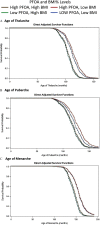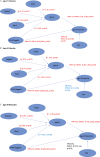Exposure to Perfluoroalkyl Substances and Associations with Pubertal Onset and Serum Reproductive Hormones in a Longitudinal Study of Young Girls in Greater Cincinnati and the San Francisco Bay Area
- PMID: 37751325
- PMCID: PMC10521915
- DOI: 10.1289/EHP11811
Exposure to Perfluoroalkyl Substances and Associations with Pubertal Onset and Serum Reproductive Hormones in a Longitudinal Study of Young Girls in Greater Cincinnati and the San Francisco Bay Area
Abstract
Background: Per- and polyfluoroalkyl substances (PFAS), endocrine disrupting chemicals with worldwide exposure, cause changes in mammary gland development in rodents. A few human studies report delay in pubertal events with increasing perfluorooctanoic acid (PFOA) exposure, but to our knowledge none have examined reproductive hormone levels at thelarche.
Methods: In a cohort of Greater Cincinnati (GC) and San Francisco Bay Area (SFBA) girls recruited at 6-8 years of age, clinical examinations were conducted annually or semiannually with sequential Tanner staging. PFAS concentrations were measured in the first serum sample of 704 girls. In 304 GC girls, estradiol (), estrone (), testosterone (T), and dihydroepiandrosterone sulfate (DHEAS) were measured in serum at four time points around puberty. Relationships between PFAS and age at thelarche, pubarche, and menarche were analyzed using survival and structural equation models. The association between PFAS and reproductive hormones was assessed using linear regression models.
Results: Median PFOA serum concentrations in GC (, ) and the SFBA (, ) were higher than in the U.S.
Population: In multivariable Cox proportional hazard models [adjusted for race, body mass index (BMI)], increasing serum log-transformed PFOA was associated with a delay in pubarche [; 95% CI: 0.70, 0.99] and menarche (; 95% CI: 0.01, 0.25). Structural equation models indicated a triangular relationship between PFOA, BMI percentile, and the age at the pubertal milestone. Increased PFOA had a statistically significant direct effect of delay on all three milestones, as did BMI. Perfluorononanoic acid (PFNA), perfluorodecanoic acid (PFDeA), and 2-(-methyl-perfluorooctane sulfonamido) acetic acid (Me-PFOSA-AcOH) also were associated with later thelarche, and Me-PFOSA-AcOH also with later pubarche. PFOA was inversely associated with DHEAS (), (), and T () concentrations at 6 months prior to puberty.
Conclusions: PFAS may delay pubertal onset through the intervening effects on BMI and reproductive hormones. The decreases in DHEAS and associated with PFOA represent biological biomarkers of effect consistent with the delay in onset of puberty. https://doi.org/10.1289/EHP11811.
Figures



Comment in
-
Invited Perspective: PFAS and Pubertal Timing in Girls-A Maturing Literature.Environ Health Perspect. 2023 Sep;131(9):91304. doi: 10.1289/EHP12658. Epub 2023 Sep 26. Environ Health Perspect. 2023. PMID: 37751324 Free PMC article. No abstract available.
References
-
- Hiatt RA, Haslam SZ, Osuch J, Breast Cancer and the Environment Research Centers. 2009. The Breast Cancer and the Environment Research Centers: transdisciplinary research on the role of the environment in breast cancer etiology. Environ Health Perspect 117(12):1814–1822, PMID: , 10.1289/ehp.0800120. - DOI - PMC - PubMed
Publication types
MeSH terms
Substances
Grants and funding
LinkOut - more resources
Full Text Sources
Miscellaneous

